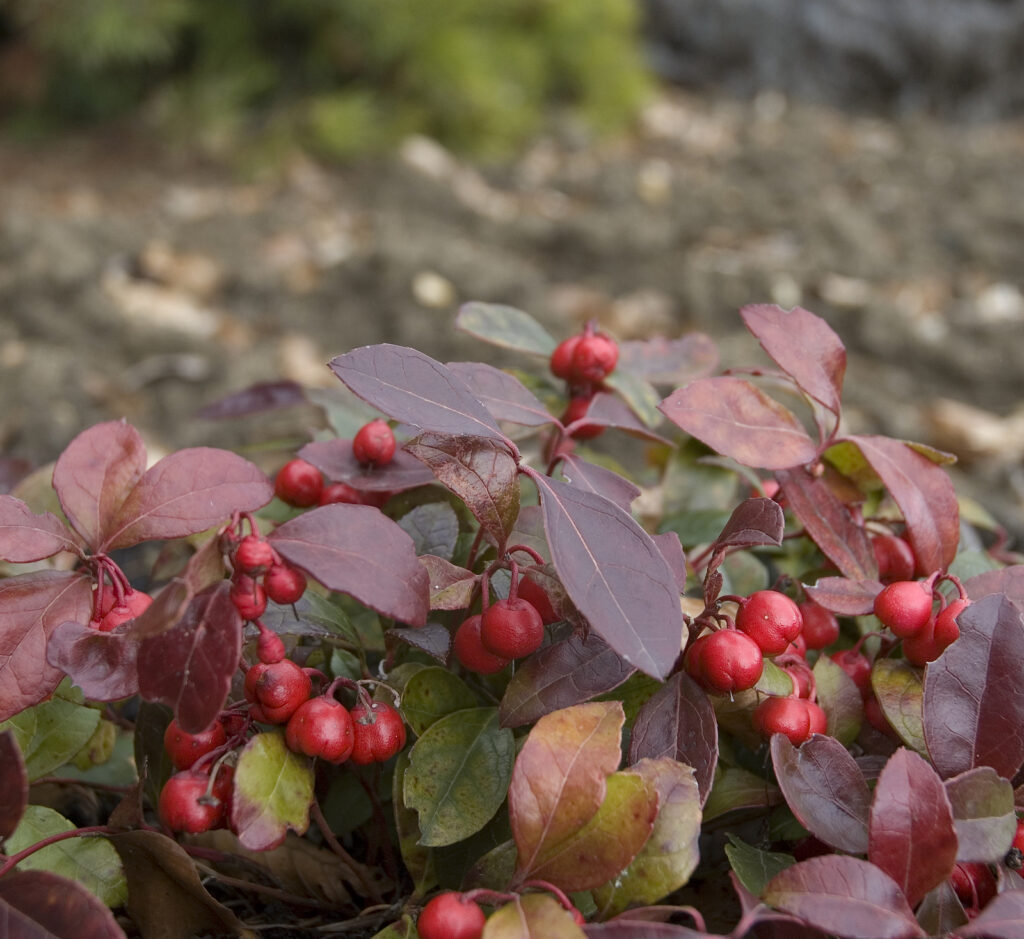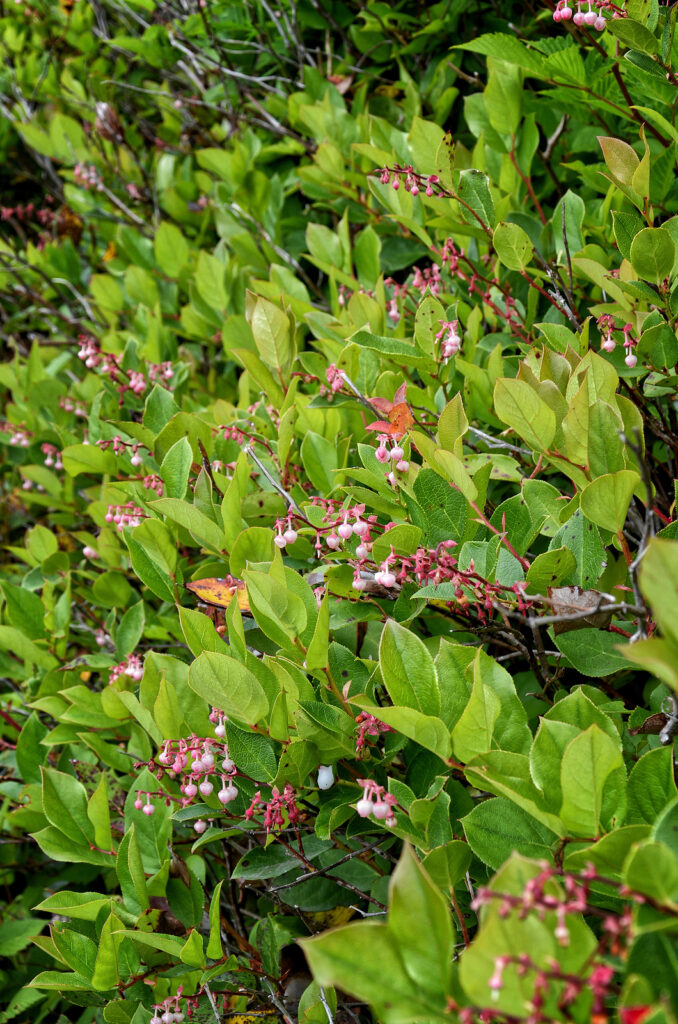Gaultheria is commonly grown for its combination of leathery leaves, small urn-shaped white flowers, and fleshy, long-lasting seed capsules. One species, Gaultheria procumbens, is a favorite low-growing ground cover for shade gardens.
Low-growing Gaultheria varieties are suitable for woodland plantings, rock garden, or as a groundcover in a moist garden or shady hillside. Taller types are good companions for other acid-soil shrubs such as rhododendrons and azaleas.
Gaultheria is a genus of almost 200 evergreen shrubs from the Americas, West Indies, and Asia.

Get to know Gaultheria
- Plant type: Low evergreen shrub.
- Growing zones and range: Zones 3 to 9 depending on the variety
- Hardiness: Hardy to Zone 3
- Height and width: 1.5 to 3 feet (.5-1m) tall and wide depending on the variety
- Growth rate: Medium.
- Form and habit: Asymmetrical, airy, spreading.
- Foliage: Rounded, leathery, lustrous, dark green 5 inches (12.7cm) long.
- Flowers: Clusters of heatherlike white to pinkish urn- or bell-shaped flowers .3 inch (.8cm).
- Fruits: Persistent purplish black berries.
- Bloom time: Spring into summer.
- Uses: Tall ground cover, along woodland margins, or in shady rock gardens.
- Garden companions: Excellent to face down rhododendrons or azaleas.
- Common name: Gaultheria
- Botanical name: Gaultheria
- Family name: Ericaceae
- Origin: North, Central, and South America
Where to plant Gaultheria
- Plant Gaultheria in partial shade, tolerates direct sun where the soil is moist.
- Gaultheria can only tolerate direct sun where the soil does not dry out
- Plant Gaultheria in well-drained, peaty soil, pH 5.5 to 6.5.
When to plant Gaultheria
- Gaultheria is most easily transplanted in early spring to soil that approximates its native site.
- Set out a young container-grown plant in a well-drained peaty bed in the acid range.

Planting and spacing Gaultheria
- Space Gaultheria 1.5 to 3 feet (.5-1m) apart depending on the variety.
- Sow seed 1/8 inch deep or slightly deeper.
How to water and feed Gaultheria
- Give Gaultheria regular water.
- Maintain moisture with Gaultheria.
- Feed Gaultheria with an all-purpose organic fertilizer in spring.
How to prune and care for Gaultheria
- Pruning season for Gaultheria is after flowering.
- Gaultheria generally needs minimal pruning except for shaping or to restrict growth.
Gaultheria pests and diseases
- Black mildew, powdery mildew, leaf gall, and fungal spots can occur.
Gaultheria propagation
- Propagate Gaultheria from rooted suckers or semi-ripe cuttings in summer.
- Sow seed in containers outdoors in a cold frame in autumn.
Gaultheria varieties to grow
- Gaultheria miqueliana, native to Japan. Dense, twiggy shrub to 1 feet (.3m) tall, with leaves to 1.5 inch (3.8cm) long and half as wide. Tiny white flowers in summer are followed by white (sometimes faintly pink-tinted) berries a little less than .5 inch (1.3cm) long.
- G. mucronata, this 4 foot (1.2m) tall, a popular suckering shrub from Chile and Argentina has upright shoots and glossy dark green leaves only .75 inch (1.8cm) long with a spine at the tip. The urn-shaped white flowers, sometimes tinged pink, are solitary and bloom in late spring to early summer. The .5 inch (1.3cm) fruits can be white or reddish-purple. Plant several to ensure fruiting. Cultivars include ‘Bell’s Seedling’ (reliable large, dark red berries), ‘Cherry Ripe’ (cherry red fruit), ‘Mother of Pearl’ (pale pink berries), and ‘Snow White’ and ‘Wintertime’ (white berries). Zones 8 and 9.
- G. ovatifolia, native to mountains in Northern California to British Columbia, east to northern Idaho. Spreading, trailing, with upright branches to about 8 inches (20.3cm) high. Oval, leathery dark green leaves, .75-1.5 inches (1.8-3.8cm) long, nearly as wide. Tiny white to pinkish flowers in summer. Bright red berries .25 inch (.5cm) wide in fall and winter are edible, wintergreen flavored. Small-scale ground cover in woodland.
- G. procumbens, Wintergreen or Checkerberry, an eastern cousin of salal native from eastern Canada south to Michigan and Georgia and grows less than 6 inches (15.2cm) tall. The shiny, dark green 2-inch (5.1cm) leaves smell of wintergreen when crushed and blush with the onset of cold weather. Quarter-inch (.6cm) flowers, white with a pink tinge, bloom from midspring to fall, while bright red fleshy seed capsules decorate the plant from midsummer through the following spring. Native Americans made a tea of its minty-tasting fruits to relieve rheumatism and fevers. Wintergreen is a beautiful creeping ground cover less that grows wild in the Northeast woods and in gardens in Zones 3 or 4 to 8. It is planted in rock gardens and as ground cover beneath low-branched trees such as hemlocks and beeches. Zones 3 to 6.
- G. shallon, Salal, the most conspicuous of the gaultherias. This West Coast native, hardy in Zones 6 to 8, is also called lemon leaf by florists, who use it in arrangements. An airy sprawling shrub that grows 5 feet (1.5m) tall and wide (lower in denser shade), with wide-spreading slim red shoots. Shoots set off the thick, glossy, nearly round 4-inch (10.2cm) leaves. In spring and summer, salal produces arching 5-inch (12.7cm) loose clusters of small waxy white or pinkish urn-shaped flowers followed by edible purple-black fruits. It’s an excellent tall ground cover for moist acid woodland soils, and it looks beautiful in front of evergreens. Zones 6 to 8.
- G. vetichiana, the 3-foot (.9m) Chinese species, hardy in Zones 7 to 9, has lustrous leaves and white-to-bluish pink bell-shaped flowers in midspring, followed by indigo blue berries.
- G. x wisleyensis, an upright, suckering hybrid 4 feet (1.2m) tall and wide with elliptic leaves 1.5 inches (3.8cm) long. Two-inch (5.1cm) racemes of white flowers bloom in late spring and early summer, followed by 1.3 inch (3.3cm) reddish fruit. Zones 7 and 9.















